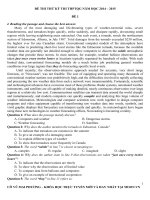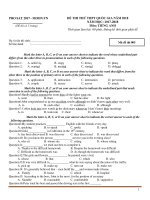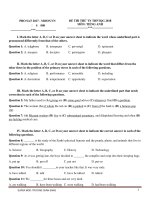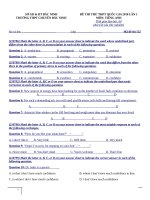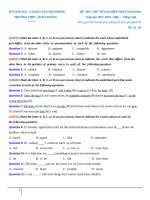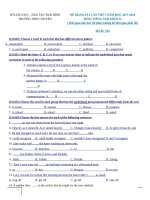12 đề thi thử tiếng anh năm 2018 – cô mai phương đề số (7)
Bạn đang xem bản rút gọn của tài liệu. Xem và tải ngay bản đầy đủ của tài liệu tại đây (576.76 KB, 13 trang )
PRO SAT 2017 - MOON.VN
CÔ VŨ MAI PHƯƠNG
ĐỀ THI KHẢO SÁT TIẾNG ANH LỚP 12
NĂM HỌC 2017 - 2018
Thời gian làm bài: 60 phút
(Đề này gồm 05 trang)
Mã đề: 010
I.
Mark the letter A, B, C, or D on your answer sheet to indicate the sentence that best joins
each of the following pairs of sentences in each of the following questions
1. Ms Hoa is a good teacher. She is also an excellent dancer.
A. Ms Hoa isn't a good teacher but an excellent dancer.
B. Ms Hoa is not only a good teacher but also an excellent dancer.
C. Not only Ms Hoa is a good teacher but also an excellent dancer.
D. Ms Hoa is both a good teacher and dances well.
2. Mr Khoat is a farmer. I bought his house.
A. Mr Khoat, who is a farmer, bought his house B. Mr Khoat, whom I bought his house, is a farmer.
C. Mr Khoat, whose house I bought, is a farmer D. Mr Khoat, who is a farmer, whose house I bought.
3. Most teachers know her well. Very few ordinary people have heard of her.
A. Many ordinary people know her better than most teachers do.
B. Not only teachers but also the general public know her as a big name.
C. Although she is well known to teachers, she is little known to the general public
D. She is the only teacher that is not known to the general public.
II.
Mark the letter A, B, C, or D on your answer sheet to show the underlined part that needs
correction
4. Do you ever feel that life is not fair to you because you cannot seem to get the job where you
A
B
C
D
want or that really suits you?
5. It is primary education that establishes foundations in science geography, history, as well
A
B
C
other social sciences for young students.
D
6. On Sundays, she enjoys to go to the concert with her friends.
A
B
C
D
7. Higher education are very important to national economy, and it is also a source of trained
A
B
and educated personnel for the whole country.
C
D
8. Not all men are concerned with a physical attractiveness of their girlfriends and wives.
A
B
C
D
III.
Read the following passage and mark the letter A, B, C, or D on your answer sheet to
indicate the correct answer to each of the questions.
In the past, both men and women were expected to be married at quite young ages. Marriages were
generally arranged by parents and family, with their children having little chance to say no in the matter. In
the past it was not surprising to find that a bride and groom had only just met on the day of their engagement
or marriage.
In modern Vietnam, this has changed completely as people choose their own marriage-partners based on
love, and in consideration primarily to their own needs and wants. Moreover early marriage is quite illegal.
The traditional Vietnamese wedding is one of the most important of traditional Vietnamese occasions.
Regardless of westernization, many of the age-old customs practiced in a traditional Vietnamese wedding
1
SUPER MOD: TRƯƠNG CHẤN SANG
continue to be celebrated by both Vietnamese in Vietnam and overseas, often combining both western and
eastern elements. Besides the wedding ceremony, there is also an engagement ceremony which takes place
usually half a year or so before the wedding. Due to the spiritual nature of the occasion, the date and time of
the marriage ceremony are decided in advance by a fortune teller.
The traditional Vietnamese wedding consists of an extensive array of ceremonies: the first is the
ceremony to ask permission to receive the bride, the second is the procession to receive the bride (along with
the ancestor ceremony at her house), the third is to bring the bride to the groom's house for another ancestor
ceremony and to welcome her into the family, then the last is a wedding banquet.
The number of guests in attendance at these banquets is huge, usually in the hundreds. Several special dishes
are served. Guests are expected to bring gifts, often money, which the groom and bride at one point in the
banquet will go from table to table collecting.
9. In the past, _________.
A. Vietnamese marriage was decided by parents and family
B. Parents had no right to interfere their children's marriage
C. Getting married at an early age was not allowed
D. Vietnamese couples were free to make a decision on the marriage
10. Which sentence is referred Vietnamese modern marriage?
A. Most young people do not have their marriage based on love.
B. Marriage is quite westernization.
C. Couples do not get married at quite young ages.
D. All marriages are arranged by parents and family.
11. Which does NOT exist in a Vietnamese wedding party?
A. dishes
B. guests
C. gifts
D. firecrackers
12. According to the passage, __________.
A. There is an engagement ceremony which takes place usually half a year or so before the wedding
B. Oversea Vietnamese people do not like to organize a traditional wedding
C. Vietnamese people never ask a fortune teller the date and time of the marriage ceremony
D. Many of the age-old customs practiced in a traditional Vietnamese wedding do not exist nowadays
13. In former days, the fact that a bride and groom had only first met just on the day of their engagement or
marriage was _________.
A. uncommon
B. surprising
C. popular
D. strange
IV.
Read the following passage and mark the letter A, B, C, or D on your answer sheet to
indicate the correct word(s) for each of the blanks..
Most Americans eat three meals during the day: breakfast, lunch, and dinner. Breakfast begins (14)_______
_______ 7:00 and 8:00am, lunch between 11:00 am and noon, and dinner between 6:00 and 8:00 pm. On
Sundays "brunch" is a combination of breakfast and lunch, typically beginning at 11:00 am. Students often
enjoy a "study break" or evening snack around 10:00 or 11:00 pm. Breakfast and lunch tend to be light
meals, with only one (15)_______ ______. Dinner is the main meal.
For breakfast Americans will eat cereal with milk which are often mixed (16)_______ ______ in a bowl,
a glass of orange juice, and toasted bread or muffin with jam, butter, or margarine. Another common
breakfast meal is scrambled eggs or an omelet with potatoes and breakfast meat (bacon or sausage). People
(17)_______ _____ are on a diet eat just a cup of yogurt. Lunch and dinner are more varied . When eating at
a formal dinner, you may be overwhelmed by the number of utensils. How do you say the (18)_______
_______ between a salad fork, a butter fork, and a dessert fork? Most Americans do not know the answer,
either. But knowing which fork or spoon to use first is simple: use the outermost utensils first and the
utensils closest to the plate last.
14. A. about
B. from
C. at
D. between
15. A. food
B. menu
C. course
D. goods
16. A. one another
B. together
C. others
D. each other
17. A. which
B. whom
C. who
D. whose
18. A. differently
B. difference
C. different
D. differ
2
SUPER MOD: TRƯƠNG CHẤN SANG
V.
Mark the letter A, B, C, or D on your answer sheet to indicate the word that differs from
the rest in the position of the main stress in each of the following questions
19. A. indicative
B. institution
C. preferential
D. university
VI.
Mark the letter A, B, C, or D on your answer sheet to indicate the word or phrase that is
OPPOSITE in meaning to the underlined part in each of the following questions.
20. School uniform is compulsory in most of Vietnamese schools.
A. forced
B. optional
C. required
D. impellent
21. There were more than 10 applicants for the vacancy for an English teacher in our school.
A. less than
B. underneath
C. least
D. over
VII.
Mark the letter A, B, C, or D on your answer sheet to indicate the word whose
underlined part is pronounced differently from that of the rest in each of the following questions.
22. A. each
B. achieve
C. chemistry
D. choice
23. A. weighed
B. helped
C. laughed
D. missed
24. A. chores
B. boys
C. parents
D. hands
VIII.
Mark the letter A, B, C, or D on your answer sheet to indicate the correct answer to
each of the
following questions.
25. If the traffic _______ bad, I will get home late.
A. were
B. had been
C. was
D. is
26. The preparations _______ by the time the guests _______.
A. had been finished / arrived
B. have finished / arrived
C. had finished / were arriving
D. have been finished / were arrived
27. He lives in a small town _______is called Taunton.
A. who
B. whom
C. where
D. which
28. He was the only _______ that was offered the job.
A. apply
B. applicant
C. application
D. applying
29. Most universities _______ students who want to attend the university to pass three A-Levels.
A. tell
B. ask
C. receive
D. require
30. Body language is a potent form of _______ communication.
A. tongue
B. oral
C. non-verbal
D. verbal
31. The boy waved his hands to his mother, who was standing at the school gate, to _______ her attention.
A. attract
B. follow
C. pull
D. tempt
32. John: " What do you think of soccer, Ann?"
Ann: " ___________________"
A. Well, it's beyond my expectation.
B. I am crazy about it.
C. Of course, soccer players are excellent
D. It's none of my business.
33. My father had the roof of the house _________ last week.
A. to repaired
B. repaired
C. repair
D. repairing
34. Sometimes I do not feel like _______ to my parents about my troubles.
A. talking
B. to talk
C. talked
D. talk
35. _______ the train last night, she________ here now.
A. If she were taking / is
B. If she took / were
C. Had she taken / would have been
D. Had she taken / would be
36. _______ to come over for dinner tonight?
A. Do you want
B. Will you want
C. Have you wanted
D. Are you wanting
37. You are old enough to be _______ for what you have done.
A. responsibly
B. responsibility
C. irresponsiblity
D. responsible
38. Peter: "- You look great in this new dress."
Mary: - ________.
A. Not at all
B. I am glad you like it
C. Do not say anything about it
D. With pleasure
39. The mother told her son _______ so impolitely.
3
SUPER MOD: TRƯƠNG CHẤN SANG
A. did not behave
B. not behaving
C. not to behave
40. She looked _______ me, smiling happily and confidently.
A. forward
B. over
C. at
D. not behave
D. on
IX.
Mark the letter A, B, C, or D on your answer sheet to indicate the word or phrase that is
CLOSEST in meaning to the underlined part in each of the following questions.
41. Billy, come and give me a hand with cooking.
A. help
B. attempt
C. be busy
D. prepared
42. Professor Berg was very interested in the diversity of cultures all over the world.
A. number
B. changes
C. conservation
D. variety
X.
Mark the letter A, B, C, or D on your answer sheet to indicate the sentence that is closest
in meaning to each of the following questions.
43. It is easy to find a job in the city now.
A. To find a job in the city is difficult now.
B. It is easy finding a job in the city now.
C. It is difficult to find a job in the city now.
D. Finding a job in the city is not difficult now.
44. We won't have a seat unless we book in advance.
A. We can't have a seat although we book in advance.
B. We won't have a seat if we don't book in advance.
C. We will have a seat if we don't book in advance.
D. We didn't have a seat because we didn't book in advance.
45. My mother started working as a teacher of Math twenty years ago.
A. My mother had worked with a teacher of Math for twenty years.
B. My mother had been working as a teacher of Math for twenty years
C. My mother has worked with a teacher of Math for twenty years.
D. My mother has been working as a teacher of Math for twenty years.
XI.
Read the following passage and mark the letter A, B, C, or D on your answer sheet to
indicate the correct answer to each of the questions..
Preparation is a key to a successful interview. Does the idea of going to a job interview make you feel a
little nervous? Many people find that it is the hardest part of the employing process. But it is not really true.
The more you prepare and practice, the more comfortable you will feel. You should find out as much as
possible about the company before you go to the interview. Understand the products that they produce and
the services that they provide. It is also good to know who the customers are and who the major competitors
are. Practice makes perfect. It will also make you feel more confident and relaxed. So, practice your answers
to common questions. Make a list of questions to ask, too. Almost all interviewers will ask if you have
questions. This is a great opportunity for you to show your keenness, enthusiasm, and knowledge. Make a
great impression. The interview is your chance to show that you are the best person for the job. Your
application or resume has already exhibited that you are qualified. Now it is up to you to show how your
skills and experience match this position and this company. The employer will be looking and listening to
determine if you are a good fit. He/she will be looking for a number of different qualities, in addition to the
skills that you possess. To make the best impression, dress appropriately; express your strengths; arrive
early, by about 10-15 minutes; be enthusiastic; shake hands firmly; be an active listener; sit up straight and
maintain eye contact; and ask questions.
After the interview, follow up with a thank-you note. This is a chance for you to restate your interest and
how you can benefit the company. Your best bet is to try to time it so that the note gets there before the
hiring: decision is made. You should also follow up with a phone call if you do not hear back from the
employer within the specified time.
46. You can show your qualifications in the_________.
A. competing with the competitors
B. resume and letter of application
C. eye contact with the interview
D. dressing style and punctuality
47. Which is not included in the writer's advice?
4
SUPER MOD: TRƯƠNG CHẤN SANG
A. You should not communicate with the interviewer after the interview.
B. You should telephone the interviewer for any information after the interview.
C. You should make the best impression in the interview.
D. You should write a note to say thanks to the interviewer after the interview.
48. The pronoun it refers to ________.
A. the job
B. the interview
C. the interviewer
D. the preparation
49. What does the writer advise you to practice?
A. Meeting some customers and competitors.
B. Making products that the company produces.
C. Asking and answering questions related to the job.
D. Providing services that the company serves.
50. Which should not be shown during your interview?
A. Punctuality
B. A firm hand shaking
C. Weaknesses
D. Being properly-dressed
***THE END***
5
SUPER MOD: TRƯƠNG CHẤN SANG
HƯỚNG DẪN GIẢI CHI TIẾT
1.B
2. C
3. C
4. D
5. C
6. B
7. A
8. B
9. A
10. C
11. D
12. A
13. C
14. D
15. C
16. B
17. C
18. B
19. A
20. B
21. A
22. D
23. A
24. C
25. D
26. A
27. D
28. B
29. D
30. C
31. A
32. B
33. B
34. A
35. D
36. A
37. D
38. B
39. C
40. C
41. A
42. D
43. D
44. B
45. D
46. B
47. A
48. B
49. C
50. C
1. B
Cô Hoa là một giáo viên giỏi. Cô ấy cũng là một vũ công tài năng.
Kết hợp cả hai câu trên: Cô Hoa vừa là giáo viên giỏi, vừa là vũ công tài năng.
Cấu trúc: not only... but also...: không những... mà còn...
Đảo ngữ: Not only + Auxiliary + S + V but…. Also...
A. Cô Hoa không phải là một giáo viên giỏi nhƣng lại là một vũ công tài năng.
B. Cô Hoa không những là một giáo viên giỏi mà còn lại là một vũ công tài năng.
C. Đảo ngữ của “Not only... but also...” nhƣng sai ngữ pháp.
D. Sau “both... and...” các từ, cụng từ phải ở cùng dạng. “dances well”->”excellent dancer”.
2. C
Ông Khoát là một nông dân. Tôi mua nhà của ông ấy.
N1+ Whose+ N2: N2 của N1. Whose thay cho tính từ sở hữu trƣớc danh từ.
A. Ông Khoát, một nông dân, mua căn nhà của ông ta.
B. Ông Khoát, ngƣời mà tôi mua nhà của ông ấy, là một nông dân.
C. Ông Khoát, ngƣời sở hữu căn nhà mà tôi mua, là một nông dân.
D. Ông Khoát, một ngƣời nông dân, ngƣời sở hữu căn nhà tôi mua.
3. C
Hầu hết giáo viên đều hiểu rõ cô ấy. Rất ít ngƣời bình thƣờng biết cô.
Although+ clause, clause: thể hiện sự trái ngƣợc, tƣơng phản.
A. Rất nhiều ngƣời bình thƣờng biết rõ cô ấy hơn các giáo viên.
B. Không chỉ các giáo viên mà cộng đồng cũng biết sự nổi tiếng của cô ấy.
C. Mặc dù cô ấy rất nổi tiếng với các giáo viên, nhƣng cô ấy lại ít đƣợc biết đến bởi cộng đồng.
D. Cô ấy là giáo viên duy nhất không đƣợc biết bởi cộng đồng.
4. D
Where-> Whether
Cấu trúc: whether... or...: dù...hay...- dùng cuối câu, nói về các trƣờng hộp có thể xảy ra.
5. C
As well-> as well as
Chủ điểm ngữ pháp: liên từ đẳng lập.
As well as= and= và.
6. B
To go-> going
Chủ điểm ngữ pháp: Động từ sau Các động từ đặc biệt: enjoy, like, love, hate,..
Enjoy+ V_ing: thích làm việc gì, diễn tả sở thích.
7. A
Is-> are
Chủ điểm ngữ pháp: Sự hòa hợp của chủ ngữ và động từ.
Chủ ngữ “Higher education” danh từ không đếm đƣợc số ít nên is-> are.
8. B
6
SUPER MOD: TRƯƠNG CHẤN SANG
Bỏ từ “attractiveness”
Chủ điểm ngữ pháp: mạo từ
“physical attractiveness” là danh từ trừu tƣợng không đếm đƣợc -> không dùng mạo từ “a/an”.
9. A
Trong quá khứ, _____.
A. Đám cƣới ở Việt Nam đƣợc quyết định bởi cha mẹ và gia đình.
B. Cha mẹ không có quyền để đại diện cho hôn nhân của con cái.
C. Kết hôn sớm thì không đƣợc cho phép.
D. Các cặp đôi ở Việt Nam đƣợc tự do ra quyết định kết hôn.
Dẫn chứng: In the past, both men and women were expected to be married at quite young ages.
Marriages were generally arranged by parents and family, with their children having little chance to
say no in the matter.
10. C
Câu nào nói đến đám cƣới Việt Nam hiện đại?
A. Hầu hết ngƣời trẻ không có hôn nhân dựa trên tình yêu.
B. Đám cƣới đƣợc Tây hóa.
C. Các cặp đôi không kết hôn khi quá trẻ.
D. Tất cả các việc hôn nhân đều do cha mẹ và gia đình sắp xếp.
Dẫn chứng: Moreover early marriage is quite illegal.
11. D
Cái gì không còn trong đám cƣới của ngƣời Việt Nam?
A. Các món ăn
B. Các vị khách
C. Các món quà
D. Pháo cƣới
Dẫn chứng: The number of guests in attendance at these banquets is huge, usually in the hundreds.
Several special dishes are served. Guests are expected to bring gifts, often money, which the groom
and bride at one point in the banquet will go from table to table collecting.
12. A
Theo đoạn văn,______.
A. Lễ đính hôn thƣờng đƣợc tổ chức trƣớc lễ cƣới khoảng nửa năm.
B. Ngƣời Việt Nam ở nƣớc ngoài không thích tổ chức lễ cƣới truyền thống.
C. Ngƣời Việt Nam không bao giờ hỏi thầy bói về ngày và giờ của lễ cƣới.
D. Rất nhiều phong tục truyền thống trong quá khứ không còn tồn tại trong lễ cƣới ngày nay.
Dẫn chứng: Besides the wedding ceremony, there is also an engagement ceremony which takes place
usually half a year or so before the wedding.
13. C
Trong quá khứ, việc cô dâu và chú rể gặp nhau lần đầu tiên ở lễ cƣới là điều...
A. Không phổ biến
B. Bất ngờ
C. Phổ biến
D. Kỳ lạ
Dẫn chứng: In the past it was not surprising to find that a bride and groom had only just met on the
day of their engagement or marriage.
14. D
7
SUPER MOD: TRƯƠNG CHẤN SANG
Between A and B: giữa A và B, trong một khoảng thời gian.
Breakfast begins (14)_______ _______ 7:00 and 8:00am, lunch between 11:00 am and noon, and
dinner between 6:00 and 8:00 pm.=> Bữa sáng bắt đầu từ 7 giờ đến 8 giờ sáng, bữa trƣa từ 11 giờ
đến 12 giờ, và bữa tối giữa 6 giờ và 8 giờ.
15. C
Food: thức ăn
Menu: thực đơn
Course: món ăn [a five-course dinner: bữa ăn 5 món]
Goods: hàng hóa
Breakfast and lunch tend to be light meals, with only one (15)_______ ______. Dinner is the main
meal.=> bữa sáng và bữa trƣa có khuynh hƣớng thành các bữa ăn nhẹ, với duy nhất một món ăn. Bữa
tối là bữa ăn chính.
16. B
One another: một cái khác
Together: cùng nhau
Others: những cái còn lại
Each other: mỗi cái khác
For breakfast Americans will eat cereal with milk which are often mixed (16)_______ ______ in a
bowl, a glass of orange juice, and toasted bread or muffin with jam, butter, or margarine.=> Với bữa
sáng, ngƣời Mỹ sẽ ăn ngũ cốc và sữa những cái thƣờng đƣợc trộn lẫn với nhau trong một cái bát, một
cóc nƣớc ép cam, và lát bánh mỳ nƣớng hoặc bánh mu-pin ăn với mứt, bơ, hay sốt margarine.
17. C
Which: cái
Whom: ngƣời (tân ngữ)
Who: ngƣời (chủ ngữ)
Whose: của ai
People (17)_______ _____ are on a diet eat just a cup of yogurt.=> những ngƣời ăn kiêng thƣờng
chỉ ăn 1 cốc sữa chua.
18. B
Differently(adv): một cách khác biệt
Difference(n): sự khác biệt
Different(adj): khác biệt
Differ(v): khác
How do you say the (18)_______ _______ between a salad fork, a butter fork, and a dessert fork?
=> Bạn có thể chỉ rõ sự khác biệt của nĩa ăn salad, nĩa ăn tiệc đứng, và nĩa để ăn tráng miệng không?
19. A
A. Indicative /in'dikətiv /
B. Institution /insti'tju:ʃn/
C. Preferential /prefə'ren∫l/
D. University /ju:ni'və:siti/
Trọng âm chính rơi vào vào âm tiết đứng trƣớc các hậu tố: - ion,- ial, -ity,...
Trọng âm chính rơi vào vào âm tiết đứng thứ 3 kể từ hậu tố: -ive, -ize,...
20. B
Compulsory= bắt buộc >< Optional= tùy ý, không bắt buộc
Required(adj) bắt buộc, force(v)= ép buộc, impellent(adj) = thúc ép.
8
SUPER MOD: TRƯƠNG CHẤN SANG
Đồng phục học sinh bị bắt buộc ở hầu hết các trƣờng ở Việt Nam.
21. A
More than = nhiều hơn >< less than= ít hơn.
Underneath (adv)= dƣới, bên dƣới; least= ít nhất; over= hơn.
Có hơn 10 ứng viên cho vị trí giáo viên tiếng Anh ở trƣờng ta.
22. D
A. Each /i:tʃ/
B. Achive /ə'tʃi:v/
C. Chemistry /'kemistri/
D. Choice /tʃɔis/
Phụ âm kép “ch” thƣờng có phiên âm quốc tế là /tʃ/ tuy nhiên có một số trƣờng hợp đặc biệt phiên
âm là /k/. Ví dụ: chemistry, school, Christmas, headache, toothache,...
23. A
A. Weighed /weid/
B. Helped /helpt/
C. Laughed /la:ft/
D. Missed /mist/
Cách phát âm đuôi “ed”
/t/: tận cùng là âm vô thanh [f,k,p,t,θ, ʃ,tʃ ]
Ví dụ: watched, looked, stopped, worked, placed, passed,...
/id/: tận cùng là [t,d], đặc biệt: động từ dạng V_ed đƣợc dùng nhƣ tính từ (wicked, aged,...)
Ví dụ: needed, wanted, decided, waited, edited, ...
/d/: tận cùng là âm hữu thanh gồm các phụ âm còn lại và nguyên âm.
Ví dụ: lived, played, studied, filled, cleaned, followed, called, prepared,...
24. C
A. Chores /tʃɔ:rz/
B. Boys /bɔiz/
C. Parents/'peərənts/
D. Hand /hændz/
Cách phát âm đuôi “-s” và “-es”
/s/: tận cùng là âm vô thanh [f,k,p,t,θ]
VD: chefs, kicks, claps, hits, paths /pɑːθs/
/s/: tận cùng là [p,pe,f,fe,gh,ph,t,te,k,ke]
VD: claps, hopes, laughs/ lɑːfs/, photographs, hats, hates, kicks, lakes,…
/iz/: tận cùng là [s,ʃ, tʃ, z, dʒ]
VD: buses, washes, catches, buzzes, judges,…
/iz/: tận cùng là [s,x,ch,sh,ce,se,ge]
VD: classes, boxes, watches, voices, horses, pages,…
/z/: tận cùng là các phụ âm còn lại – phụ âm hữu thanh [b, d, g,l, m, n, r, v, ð] sau các nguyên âm
VD: rubs, cards, eggs, walls, names, cleans, wears, lives, clothes, tries /traiz/, toys / toiz/,…
25. D
Chủ điểm ngữ pháp: Câu điều kiện loại 1
Nói về những điều có khả năng xảy ra ở hiện tại, tƣơng lai:
If+ S+ V(s/es), S+ will/can/may,...+ V(nt).
Nếu tình hình giao thông tồi tệ, tôi sẽ về đến nhà muộn.
9
SUPER MOD: TRƯƠNG CHẤN SANG
26. A
Chủ điểm ngữ pháp: Câu bị động với thì QKHT:
S+ had+ been+ PP+ (by O)...
Sự phối hợp giữa các thì:
S+had +PP, when/while + S+ V_ed: diễn tả 1 sự việc kết thúc trƣớc khi sự việc khác xảy ra trong quá
khứ.
Tất cả sự chuẩn bị đã đƣợc hoàn thành trƣớc khi các vị khách đến.
27. D
Chủ điểm ngữ pháp: Trạng từ quan hệ
Where: là trạng từ quan hệ chỉ nơi trốn, thay cho a, on, in + which.
Anh ấy sống ở một thị trấn nhỏ, nơi đƣợc gọi tên là Taunton.
28. B
Chủ điểm ngữ pháp: từ loại
Apply (v)= ứng cử, applicant(n)= ứng cử viên, application(n)= sự ứng tuyển, applying: V_ing.
Anh ấy là ứng cử viên duy nhất đƣợc đề nghị công việc này.
29. D
Chủ điểm ngữ pháp: từ loại
Tell (v)= nói, ask (v)= hỏi, receive(v)= nhận đƣợc, require(v)= yêu cầu.
Hầu hết các trƣờng đại học đều yêu cầu những học sinh muốn đăng ký vào trƣờng cần tốt nghiệp
THPT.
30. C
Chủ điểm ngữ pháp: từ loại
Tongue(n)= cách nói, oral (adj)= bằng lời nói, non-verbal(adj)= không lời, verbal (adj)= bằng lời.
Ngôn ngữ cơ thể là một hình thức giao tiếp phi ngôn ngữ mạnh.
31. A
Chủ điểm ngữ pháp: sự kết hợp từ [ collocation]
To attract sb’s attention: thu hút sự chú ý của ai đó
Cậu bé vẫy tay về phía mẹ mình, ngƣời đang đứng ở sân trƣờng, để bà ấy thấy.
32. B
John: “Bạn nghĩ gì về bóng đá hả Ann?” – Ann: “ ....”
Tobe crazy about+ sb/sth: hâm mộ, yêu thích (ai, cái gì)
A. Ồ, nó vƣợt xa mong đợi của tôi.
B. Tôi cực kỳ yêu thích nó.
C. Chắc chắn rồi, các cầu thủ bóng đá rất suất sắc.
D. Đó không phải việc của tôi.
33. B
Chủ điểm ngữ pháp: câu bị động
Dạng đặc biệt với have/ get:
S + have + O + PP.2 + (by+ Sb) đƣợc thực hiện bởi ngƣời khác.
Bố tôi đƣợc giúp sửa mái nhà tuần trƣớc.
34. A
Feel like (doing) sth: mong muốn làm gì đó.
Đôi khi tôi không muốn nói với bố mẹ về các vấn đề của mình.
35. D
Chủ điểm ngữ pháp: đảo ngữ câu điều kiện phức hợp
10
SUPER MOD: TRƯƠNG CHẤN SANG
If+ S+ had+ PP, S+ would+ V(nt) + (now)-> Had+ S+ PP, S+ would+ V(nt) + (now).
Nếu cô ấy bắt chuyến tàu tối qua, bây giờ cô ấy đã ở đây rồi.
36. A
Come over= ghé qua.
Lời mời: Do you want + to do sth: bạn có muốn (làm gì) không?
Bạn có muốn qua ăn tối hôm nay không?
37. D
Tobe+ adj+enough+ to V: đủ ... để làm việc gì.
Tobe+ responsible+ for sth: chịu trách nhiệm cho việc gì.
38. B
Peter: “Bạn trông thật tuyệt trong chiếc váy mới.” – Mary: “...”
A. Không có gì. (Khi nhận đƣợc lời cảm ơn hay xin lỗi)
B. Tôi rất vui vì bạn thích nó. (hàm ý nhƣ lời cảm ơn)
C. Đừng nói thêm về nó nữa.
D. Rất vinh hạnh. (Cách trả lời đồng ý khi đƣợc nhờ làm việc gì đó.)
39. C
Tell+ sb+ (not) to V: yêu cầu, dặn ai làm gì.
Ngƣời mẹ nhắc nhở đứa con không đƣợc cƣ xử một cách vô lễ.
40. C
Chủ điểm ngữ pháp: sự kết hợp từ [ collocation]
Look at= ngắm, nhìn vào; look foward to= trông đợi, look over= kiểm tra, look on= nhìn kỹ.
Cô ấy nhìn vào tôi, mỉm cƣời một cách tự tin và hạnh phúc.
41. A
Give + sb + a hand = help (v): giúp đỡ ai đó.
Attempt (v)= cố, thử
Be busy (adj) = bận rộn
Prepared (adj)= chuẩn bị
Billy, lại đây và giúp mẹ nấu ăn.
42. D
Diversity = variety (n): sự đa dạng
Number (n)= con số
Change (n)= sự thay đổi
Conservation (n)= sự bảo tồn
Giáo sƣ Berg rất hứng thú về sự đa dạng văn hóa thế giới.
43. D
Thật dễ dàng để tìm việc ở thành phố thời điểm này.
Chủ ngữ giả: It+ tobe+ adj+ to V: (nhƣ thế nào) để làm việc gì đó.
Danh động từ V_ing, Động từ nguyên thể To V làm chủ ngữ của câu.
A. Bây giờ, để tìm việc ở thành phố rất khó khăn.
B. ( Cùng nghĩa với câu gốc, sai ngữ pháp)
C. Thật khó khăn để tìm việc ở thành phố bây giờ.
D. Bây giờ, tìm việc ở thành phố không khó khăn.
44. B
Chúng ta sẽ không có chỗ ngồi trừ khi đặt vé trƣớc.
Book: đặt chỗ, vé. In advance= trƣớc.
11
SUPER MOD: TRƯƠNG CHẤN SANG
Câu điều kiện: Unless...= If ... not...
A. Chúng ta không thể có chỗ ngồi dù đã đặt vé trƣớc.
B. Chúng ta sẽ không có chỗ ngồi nếu ta không đặt vé trƣớc.
C. Chúng ta sẽ có chỗ ngồi nếu ta không đặt vé trƣớc.
D. Chúng ta đã không có chỗ ngồi vì chúng ta đã không đặt vé trƣớc.
45. D
Mẹ tôi đã bắt đầu công việc làm giáo viên toán 20 năm về trƣớc.
Thì Quá khứ đơn: S+V_ed+ mốc/ khoảng thời gian.
Thì Hiện tại hoàn thành tiếp diễn: S+ have+ been+ V_ing: diễn tả một việc bắt đầu trong quá khứ,
tiếp túc ở hiện tại và tƣơng lai.
A. Mẹ tôi đã từng làm việc với một giáo viên toán đƣợc 20 năm.
B. Mẹ tôi đã từng làm giáo viên toán đƣợc 20 năm.
C. Mẹ tôi đã và đang làm việc với một giáo viên toán đƣợc 20 năm.
D. Mẹ tôi đã và đang làm giáo viên toán đƣợc 20 năm.
46. B
Bạn có thể trƣng bày bằng cấp của mình ở...
A. Cạnh tranh với đối thủ.
B. Bản lý lịch hoặc thƣ xin việc.
C. Giao tiếp bằng mắt trong buổi phỏng vấn.
D. Mặc lịch sự và đúng giờ.
Dẫn chứng: Your application or resume has already exhibited that you are qualified.
47. A
Điều gì không nằm trong các lời khuyên của tác giả?
A. Bạn không nên giao tiếp với ngƣời tuyển dụng sau buổi phỏng vấn.
B. Bạn nên gọi cho ngƣời phỏng vấn để hỏi về bất kỳ thông tin nào sau buổi phỏng vấn.
C. Bạn nên tạo ấn tƣợng tốt nhất trong buổi phỏng vấn
D. Bạn nên viết một lá thƣ cảm ơn sau buổi phỏng vấn.
Dẫn chứng: Make a great impression.... After the interview, follow up with a thank-you note... You
should also follow up with a phone call if you do not hear back from the employer within the
specified time.
48. B
Đại từ “it” nhằm ám chỉ đến...
A. Công việc
B. Buổi phỏng vấn
C. Ngƣời phỏng vấn
D. Sự chuẩn bị
Dẫn chứng: Does the idea of going to a job interview make you feel a little nervous? Many people
find that it is the hardest part of the employing process.
49. C
Ngƣời viết khuyên bạn nên tập luyện việc gì?
A. Gặp gỡ vài khách hàng và đối thủ.
B. Làm các sản phẩm công ty sản xuất ra.
C. Hỏi và trả lời các câu hỏi liên quan đến công việc.
D. Cung cấp các dịch vụ mà công ty phục vụ.
12
SUPER MOD: TRƯƠNG CHẤN SANG
Dẫn chứng: Make a list of questions to ask, too. Almost all interviewers will ask if you have
questions.
50. C
Điều gì không nên thể hiện trong buổi phỏng vấn của bạn?
A. Sự đúng giờ
B. Một cái bắt tay dứt khoát
C. Điểm yếu
D. Trang phục chỉn chu
Dẫn chứng: To make the best impression, dress appropriately; express your strengths; arrive early, by
about 10-15 minutes; be enthusiastic; shake hands firmly; be an active listener; sit up straight and
maintain eye contact; and ask questions.
13
SUPER MOD: TRƯƠNG CHẤN SANG
